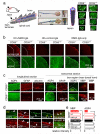Longitudinally extensive NMO spinal cord pathology produced by passive transfer of NMO-IgG in mice lacking complement inhibitor CD59
- PMID: 24698947
- PMCID: PMC4162764
- DOI: 10.1016/j.jaut.2014.02.011
Longitudinally extensive NMO spinal cord pathology produced by passive transfer of NMO-IgG in mice lacking complement inhibitor CD59
Abstract
Spinal cord pathology with inflammatory, demyelinating lesions spanning three or more vertebral segments is a characteristic feature of neuromyelitis optica (NMO). NMO pathogenesis is thought to involve binding of immunoglobulin G anti-aquaporin-4 autoantibodies (NMO-IgG) to astrocytes, causing complement-dependent cytotoxicity (CDC) and secondary inflammation, demyelination and neuron loss. We investigated the involvement of CD59, a glycophosphoinositol (GPI)-anchored membrane protein on astrocytes that inhibits formation of the terminal C5b-9 membrane attack complex. CD59 inhibition by a neutralizing monoclonal antibody greatly increased NMO-IgG-dependent CDC in murine astrocyte cultures and ex vivo spinal cord slice cultures. Greatly increased NMO pathology was also found in spinal cord slice cultures from CD59 knockout mice, and in vivo following intracerebral injection of NMO-IgG and human complement. Intrathecal injection (at L5-L6) of small amounts of NMO-IgG and human complement in CD59-deficient mice produced robust, longitudinally extensive white matter lesions in lumbar spinal cord. Pathology was most severe at day 2 after injection, showing loss of AQP4 and GFAP, C5b-9 deposition, microglial activation, granulocyte infiltration, and demyelination. Hind limb motor function was remarkably impaired as well. There was partial remyelination and recovery of motor function by day 5. Our results implicate CD59 as an important modulator of the immune response in NMO, and provide a novel animal model of NMO that closely recapitulates human NMO pathology. Up-regulation of CD59 on astrocytes may have therapeutic benefit in NMO.
Keywords: Aquaporin-4; Astrocyte; Complement-dependent cytotoxicity; Demyelination; NMO.
Copyright © 2014 Elsevier Ltd. All rights reserved.
Figures







Similar articles
-
Marked central nervous system pathology in CD59 knockout rats following passive transfer of Neuromyelitis optica immunoglobulin G.Acta Neuropathol Commun. 2017 Feb 17;5(1):15. doi: 10.1186/s40478-017-0417-9. Acta Neuropathol Commun. 2017. PMID: 28212662 Free PMC article.
-
Ex vivo spinal cord slice model of neuromyelitis optica reveals novel immunopathogenic mechanisms.Ann Neurol. 2011 Dec;70(6):943-54. doi: 10.1002/ana.22551. Epub 2011 Nov 8. Ann Neurol. 2011. PMID: 22069219 Free PMC article.
-
Experimental mouse model of optic neuritis with inflammatory demyelination produced by passive transfer of neuromyelitis optica-immunoglobulin G.J Neuroinflammation. 2014 Jan 27;11:16. doi: 10.1186/1742-2094-11-16. J Neuroinflammation. 2014. PMID: 24468108 Free PMC article.
-
[Recent progress in multiple sclerosis research: astrocytopathy in demyelinating diseases].Rinsho Shinkeigaku. 2010 Nov;50(11):788-93. doi: 10.5692/clinicalneurol.50.788. Rinsho Shinkeigaku. 2010. PMID: 21921443 Review. Japanese.
-
[Pathology of neuromyelitis optica].Rinsho Shinkeigaku. 2009 Nov;49(11):896-9. doi: 10.5692/clinicalneurol.49.896. Rinsho Shinkeigaku. 2009. PMID: 20030242 Review. Japanese.
Cited by
-
Neuromyelitis Optica Spectrum Disorder: From Basic Research to Clinical Perspectives.Int J Mol Sci. 2022 Jul 18;23(14):7908. doi: 10.3390/ijms23147908. Int J Mol Sci. 2022. PMID: 35887254 Free PMC article. Review.
-
Scientific issues with rodent models of neuromyelitis optic spectrum disorders.Front Immunol. 2024 Nov 19;15:1423107. doi: 10.3389/fimmu.2024.1423107. eCollection 2024. Front Immunol. 2024. PMID: 39628487 Free PMC article. Review.
-
Membrane assembly of aquaporin-4 autoantibodies regulates classical complement activation in neuromyelitis optica.J Clin Invest. 2019 Apr 8;129(5):2000-2013. doi: 10.1172/JCI122942. eCollection 2019 Apr 8. J Clin Invest. 2019. PMID: 30958797 Free PMC article.
-
Friend or foe: assessing the value of animal models for facilitating clinical breakthroughs in complement research.J Clin Invest. 2025 Jun 16;135(12):e188347. doi: 10.1172/JCI188347. eCollection 2025 Jun 16. J Clin Invest. 2025. PMID: 40519165 Free PMC article. Review.
-
Proteome Profile of Myelin in the Zebrafish Brain.Front Cell Dev Biol. 2021 Apr 8;9:640169. doi: 10.3389/fcell.2021.640169. eCollection 2021. Front Cell Dev Biol. 2021. PMID: 33898427 Free PMC article.
References
-
- Jarius S, Paul F, Franciotta D, Waters P, Zipp F, Hohlfeld R, et al. Mechanisms of disease: aquaporin-4 antibodies in neuromyelitis optica. Nat Clin Pract Neurol. 2008;4:202–14. - PubMed
-
- Wingerchuk DM, Lennon VA, Lucchinetti CF, Pittock SJ, Weinshenker BG. The spectrum of neuromyelitis optica. Lancet Neurol. 2007;6:805–15. - PubMed
-
- Jarius S, Wildemann B. AQP4 antibodies in neuromyelitis optica: diagnostic and pathogenetic relevance. Nat Rev Neurol. 2010;6:383–92. - PubMed
Publication types
MeSH terms
Substances
Supplementary concepts
Grants and funding
LinkOut - more resources
Full Text Sources
Other Literature Sources
Molecular Biology Databases
Miscellaneous

